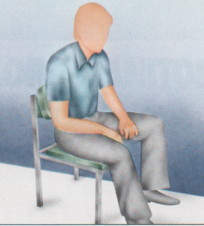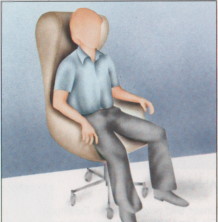Autogenic training: More and more people suffer from Sleep problems. While 52.5 percent said they had no problems with their sleep in a survey conducted by the DAK in 2009, the figure had fallen to 21.1 percent by 2016. In 2016, around one-third of respondents said they suffered from sleep problems not only from time to time, but particularly frequently. Yet good sleep is essential for physical and mental regeneration in order to be mentally and physically productive during the day. One way to combat sleep problems is autogenic training, which can not only provide deep relaxation, but also many other positive effects. How can you learn autogenic training?

Your individual sleep blend
With natural methods such as the individual spagyric sprays from Zimply Natural, complaints can be treated and sustainably alleviated.
What is autogenic training?
Autogenic training - A special kind of self-hypnosis
Autogenic training is a relaxation technique based on autosuggestion. An autosuggestion is a process in which a person causes their subconscious mind to develop and solidify a certain belief through self-hypnosis and repeated affirmations. In this process, the same formulaic thought is repeated over an extended period of time in the form of mental exercises until it becomes ingrained in the subconscious thought process. The desired effect of autosuggestive formulas can be enhanced by relaxation techniques and mental visualizations. Moreover, the more regularly, longer and more frequently the autosuggestions are trained, the more likely they are to occur.

Autogenic training is a special type of self-hypnosis through which the body and associated vegetative functions, such as blood flow, heart rate and breathing, can be brought into a trance-like state of relaxation. By means of autosuggestions such as "I am completely calm" or "The left arm is completely warm", ideas are generated that manifest the desired feeling after a few repetitions.
In contrast to progressive muscle relaxation, the state of relaxation is not produced by external, physical action, by consciously tensing the muscles, but by mental focus from within.
Origins: The power of thought
In the 19th century, the French pharmacist Émile Coué recognized that the effect of his customers' medicines was influenced by the words he used to give them to them. From this observation he developed the doctrine of autosuggestion - and with it the conviction that physical and mental well-being could be influenced solely by suggestive formulas repeated over and over again.
Autogenic training, which goes back to the German psychiatrist Johannes Heinrich Schultz (1884-1970), is based on this knowledge. He studied the effects of hypnosis for a long time, recognizing the effect of suggestions, i.e. mental and emotional influences through encouragement during hypnosis. In 1932, he developed the method of autogenic training, which he initially called "concentrative self-relaxation." Today, autogenic training is not only a generally known relaxation method, but in Germany and Austria even a legally recognized method of psychotherapy, which is often used for vegetative disorders.
Techniques of calming by self-influence were already practiced in ancient times, such as in the Indian yoga teachings or the Japanese Zen meditation. However, these methods can hardly be considered independent of the ideological thought of the teachings of the Buddha, the so-called Satipatthana. Autogenic training, on the other hand, is the first relaxation method of this kind that can be performed independently of culture and worldview.
Autogenic training: psychological background

Autogenic training represents a form of self-hypnosis, since the trainee puts himself into a switched hypnotic state through autosuggestion, which is lifted again after the training.
Johannes H. Schultz is convinced that it is possible for most people to put themselves into a deep state of relaxation with the help of their imagination alone. This effect could also be confirmed in scientific investigations: For example, people who intensely imagined warmth in their arms subsequently experienced an increase in their surface temperature in these areas. This effect is due to an increase in blood flow in the body.
According to Schultz, the feeling of inner peace is largely determined by muscle relaxation and the message it sends to the brain that there is relaxation in the body. The starting point of this psychotherapeutic method is therefore primarily the physical influence of muscle and vascular relaxation, which in turn has an influence on the psyche.
Effects of autogenic training on body & mind
When autogenic training is done regularly and correctly, it can have health-promoting effects, including:
- Reduction of muscle tension and posture problems
- Relief from gastrointestinal complaints
- Reduction of chronic pain, such as Headache and migraine
- Increase in performance and concentration
- Increased resistance and Stress tolerance
- More calm and serenity
Autogenic training is predominantly used to reduce stress, increase general quality of life, enhance athletic performance, in managerial training, in the prevention of burnout syndrome, and for increased performance. In addition, it is suitable for reducing sleep disorders by reducing stress and promoting physical relaxation. The exercises can also be used in some psychological and psychosomatic disorders and have a positive effect on chronic pain. In the case of strong physiological regulation disorders, such as heart palpitations or fainting spells, the training should be performed cautiously. They are also not suitable for patients with psychoses.
How does autogenic training work?
Autogenic training is best done in group or individual sessions, under the guidance of a trained staff. However, guidance through guided meditation, books, CDs or DVDs is also possible.
The training is performed in a sitting position, in a special posture, traditionally in the so-called "cabman's posture", or in a lying position - if possible three times a day, at least once in a lying position and once in a sitting position. The posture should be as comfortable as possible for the practitioner, even over a long period of time.
The traditional postures are:
- Cab driver posture
- Sitting posture on a chair, if necessary with armrests and headrest
- Lying posture
- Desk posture

DK attitude

Sitting posture

Lying posture

Desk posture
Phases and exercises of autogenic training
Autogenic training is composed of two stages. In the first stage, the so-called basic stage, the main aim is to influence physical processes. The formulas of this stage address the autonomic nervous system and should always be formulated in the same wording, in simple, short sentences, in order to bring about conditioning in the long term. How the practitioner visualizes the formulas best, so that the desired effect occurs, must be found out individually.
The basic exercises of the lower level are:
1. the rest exercise

2. the gravity exercise

3. the heat exercise

4. the breathing exercise

5. the solar plexus exercise

6. the heart exercise

The heart exercise focuses on the pulse to calm it. One possible exercise formula is "The heart beats very calmly and evenly". The heart exercise is intended to stabilize and normalize blood pressure in the long term.
7. the head exercise

The idea of a cool and clear head during the head exercise is to achieve a high level of mental clarity. Formulas of the head exercise can be, for example, "My head is pleasantly cool and clear". The facial muscles relax and tension and headaches subside.
The termination
All exercises are followed at the end by the so-called "withdrawal" to cancel the hypnotic state again - if the exercises were not used to fall asleep. To do this, first clench your fists and hit your shoulders with them with tense muscles. Then the arms are loosely returned to the starting position. This is done three to five times. The last time, the practitioner keeps the clenched fists up, pauses briefly, takes a jerky breath while widening his eyes, and abruptly calls out a short, explosive sound. After this process, the practitioner should feel fresh and awake. If he still feels woozy, the process is repeated a few more times.
The protocol
Another important factor in the success of autogenic training is the examination of the experience in the form of a log in which the practitioner notes down his or her sensations during the exercises once a day.
The second phase of autogenic training, the so-called upper level, is suitable for advanced students. This is because it is a basic requirement to master the exercises of the basic level in such a way that it is possible to switch to a state of relaxation within a very short time, so that the upper level can be implemented successfully.
The upper level consists of seven successive sub-levels with individual autosuggestions as formulas and has the goal of influencing the behavior of the trainee through formulaic resolution formation. Through a "waking dream technique" meditative, pictorial ideas arise in the subconscious, which then reach the consciousness and can be reflected upon there. This technique can lead to deep self-knowledge and, supervised by a psychotherapist, can also be used for conflict management and resolution.
Guided autogenic training to get started
Since the basic exercises are the basis of autogenic training, you should start with them. We recommend you the guided meditation of the Youtube channel "Minddrops", which leads you with relaxed music and voice through the individual phases of the lower level.








